This article contains spoilers from the fifth and final season of "She-Ra and the Princesses of Power."
She-Ra and the Princesses of Power (2018), a Netflix original TV series created by showrunner Noelle Stevenson, is a groundbreaking foundation for a new wave of positive lesbian and queer representation in children's media.
Based on the original 1980s version created by Larry DiTillio and J. Michael Straczynski, Stevenson's intellectual and creative remake of the infamous She-Ra persona tackles complex issues such as emotional and physical parental abuse, identity and conformity, and religious trauma. The story adheres close to the original plot with Adora, an evil Horde member living on the planet of Etheria, finding a magical sword in an enchanted forest that allows her to turn into the warrior She-Ra, princess of power. In Stevenson's version, Adora soon defects from the Horde and joins the Princess Rebellion to not only fight against the Horde but also her best-friend-turned-enemy, Catra.
The series aired its fifth and final season on May 15th, 2020. Despite fan worries of an inconclusive ending of a heavily implied lesbian romance between the two female leads, She-Ra delivered extraordinarily.
Throughout the entirety of the show, the audience was able to follow the ever-changing complexities of Adora and Catra's relationship as their individual motivations grew more polarized from each other. Like an ocean brushing over shores, their emotional connection pushes and pulls them into new realizations about their own identities and leads them on separate paths that beautifully meet once again. While most TV series often imply, undermine or underdeveloped and add in lesbian relationships as a secondary or tertiary characteristic to the show, She-Ra consistently and eloquently reminds the audience that Adora and Catra's relationship is the heart of the show. To deny the significance and realness of their romance is to deny the essence and message of the show itself: love always conquers hate and prejudice--common sentiments in which many in the queer community face simply for existing as themselves.
One shining aspect of how She-Ra presents a solid queer romance in the spotlight without diminishing the integrity of the characters as individuals—like other shows often do—is especially exemplified through Catra's character arcs.
Catra has been shown throughout season one through three to make bad decisions that endanger the Rebellion and Etherian people. The ending arc for season three brought Catra to a personal catalyst when she opens a portal that nearly destroys the entire universe. An act which seemingly severs the last bit of faith Adora had in her ex-best friend being good. Catra realizes the terrible extent of her actions but in stubbornness and fear of that recognition, she ignores it and consequently hits rock bottom in season four as guilt swells inside her.
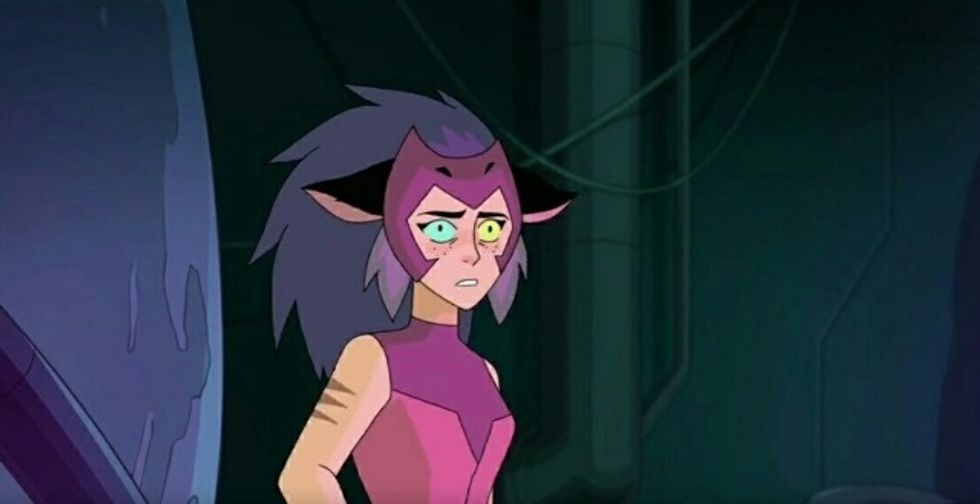
In season four, Catra provides glimpses of her potential for redemption in various scenes. These moments, unfortunately, are short-lived. Resurfacing guilt over her actions and trauma from parental abuse in the prior seasons, the heartache of thinking that she has lost Adora, her best friend and only love, for good, and the pressure of being second-in-command for a cause she secretly doubts emphasizes the nature of Catra's tragic character design.
In season five, Catra remembers her childhood promise to Adora to protect each other when she stands in the middle of two corridors—one dark and the other filled with light—in the alien spacecraft that abducted her and Queen Glimmer of Brightmoon, Adora's closest rebellion friend, at the climax of the season four finale. In poetic visual symbolism to Robert Frost's poem, The Road Not Taken, Catra chooses the path that she believed she would not and was often told that she inherently couldn't take—the path of good. Following the sacrificial redemption trope route, Catra frees Glimmer from her prison and helps her escape while letting herself be taken instead, presumably to die. Catra tells Glimmer that she is doing it for Adora. She also expresses that there is no one else in the universe left who cares for her.
Strategically, the scene cuts to a worried Adora. At this point, the audience truly witnesses the tidal wave of Adora's and Catra's accumulated feelings for each other rise extremely high. Despite everything Catra has done, Adora rushes to save her amid a planetary takeover of her people. In fact, Adora cares so much for Catra that it is witnessing Catra's near death through the forced conversion and control of Horde Prime, a strongly contextualized metaphor of the homophobic religious leader, that Adora is able to fully unlock her She-Ra power once again after breaking She-Ra's sword—the assumed 'trigger' for her powers—in season four.
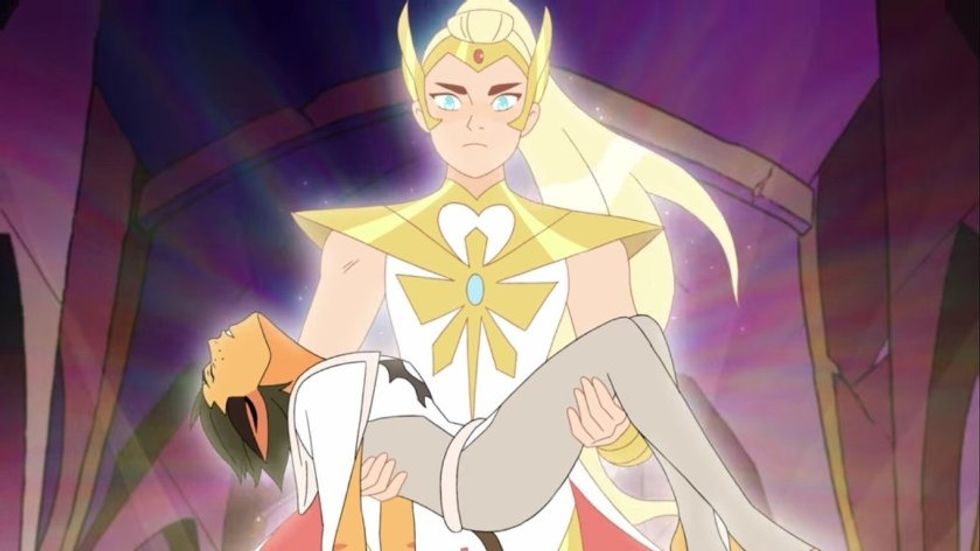
Subverting the expectations of the sacrificial trope, Catra is saved. This allows her to work at being a better person. In this time the audience also watches Adora and Catra deal with repression and fear of expression for their underlying love in more productive ways. Adora and Catra openly flirt, tease, and bond but whereas Catra always knew she loved Adora, Adora's repression of her desires bloom in front of her for the first time without the condescending eyes of the equally homophobic metaphor of the Horde watching her. It is a compelling and often recognizable story for many queer youths today on hiding your homosexuality and repressing your identities to the point of inner turmoil.
Seeing the titular main female lead openly flirt and romantically yearn for another female is a paramount experience in children's media. Previous children's media such as Steven Universe, Legend of Korra and Adventure Time have all made positive strides toward queer representation. However, the romances were either small subplots, confirmed at the very end, shown only in secondary characters, or not properly canonized until comics after the series initial conclusion.
She-Ra allows not only the main female leads to have an active romance throughout the series but also places it at the core of the show and is necessary for the heroes to save the universe and conclude the show. How many children and even adult shows have we seen where queer love is risen, needed and valued at the levels of heterosexual-gratifying heroic tales that have been told since media's inception?
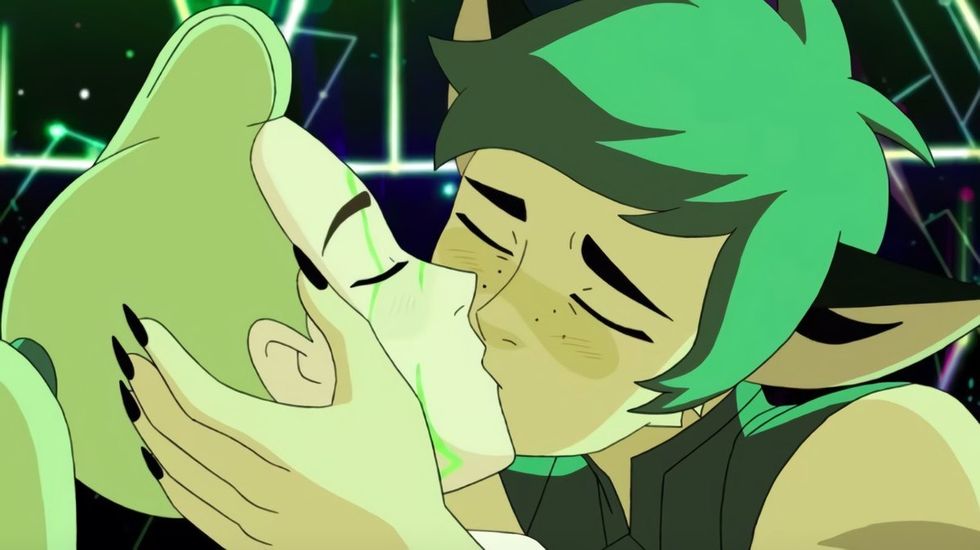
In the hair-raising ending of the show, Adora and Catra share a mutual verbal love confession and an unabashed long romantic kiss that isn't a blink-and-you-miss-it moment usually seen for queer representation in mainstream media of all kind. What is even more important about She-Ra's ending is that there is no way for foreign countries with stricter media laws on homosexual depictions to censor it out because without their kiss, there is no ending and explanation to the ending. Previous shows have had queer kisses or confirmed relationship statuses at the very end of the show or in throwaway scenes that could easily be altered.
As a lesbian myself, it was so important for the little gay Nia inside my memory to see their love story unfold in such an affirming way. Neither character is perfect, but they are also not fundamentally villainous. Their lesbian identity is a part of their character but not the whole. Adora and Catra can be people just like heterosexual characters while having overt romantic feelings exclusively for women and for each other.
Many lesbian and queer children can fully see characters like them because of She-Ra and see them be main three-dimensional characters, and most importantly, have the happy endings often depicted to be reserved for heterosexual audiences and people. Adora saves the day and gets the girl. There is even a scene where Adora heavily implies and realizes her desire for a future where she is together and married to Catra as pictured below.
When I was a kid, I was never allowed or given the freedom of possibility to dream about a happy future with a wife. I was told by society that only girls who wanted boys could have that type of happiness. I, like many gay children, was taught socially and culturally that I deserved to be alone and should expect it.
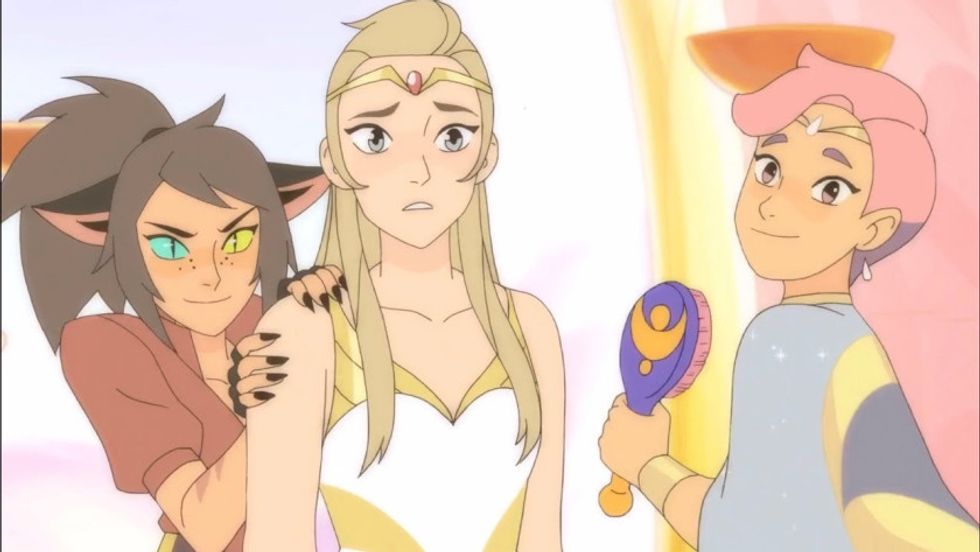
Harmful lesbian portrayals often show one or both of the characters dying, suffering or being unable to be with their love interest for a variety of homonegative and heteronormative reasons. However, while Adora and Catra face death and difficulties like other characters, neither have to sacrifice their life because of their homosexuality.
This is crucial when LGBTQ youth are almost five times as likely to have attempted suicide compared to heterosexual youth. She-Ra explicitly affirm to children multiple times that they deserve happiness too, regardless of their sexuality or where they came from and what homophobic authorities have attempted to indoctrinate into them.
She-Ra also depicts LGBTQ relationships and people throughout the entire show as natural as it can show heterosexual-presenting people.
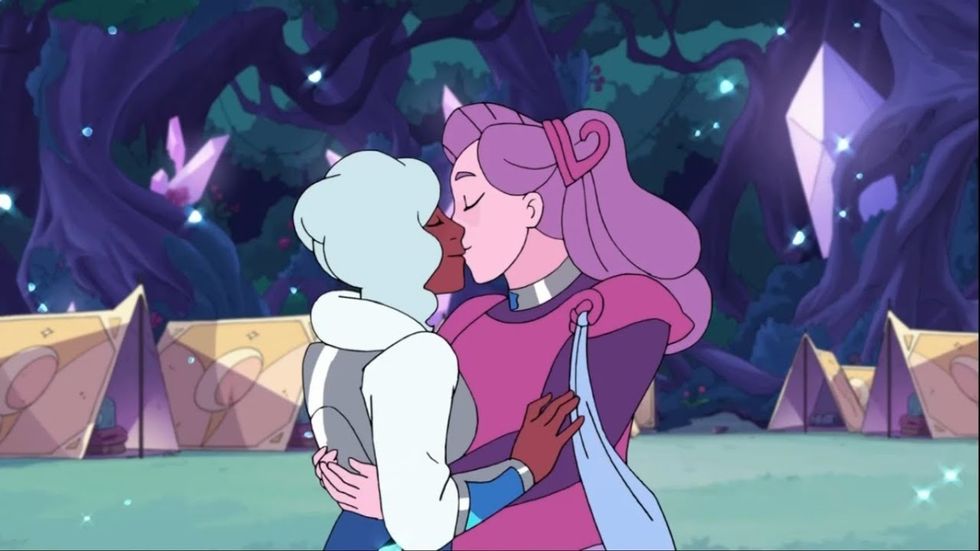
One of the main character's, Bow, has two dads and their relationship is not treated any differently than a mom and dad would be. Two minor characters that appear throughout the series, Spinnerella and Netossa, are canonical wives and share a brief kiss on screen. Double Trouble, a character pivotal to Catra's redemption, is a nonbinary character and uses they/them pronouns, which is groundbreaking for trans and nonbinary representation as it is not seen as frequently as LGB representation. This only scratches the surface of the amount of queer representation Stevenson proudly integrates into her series.
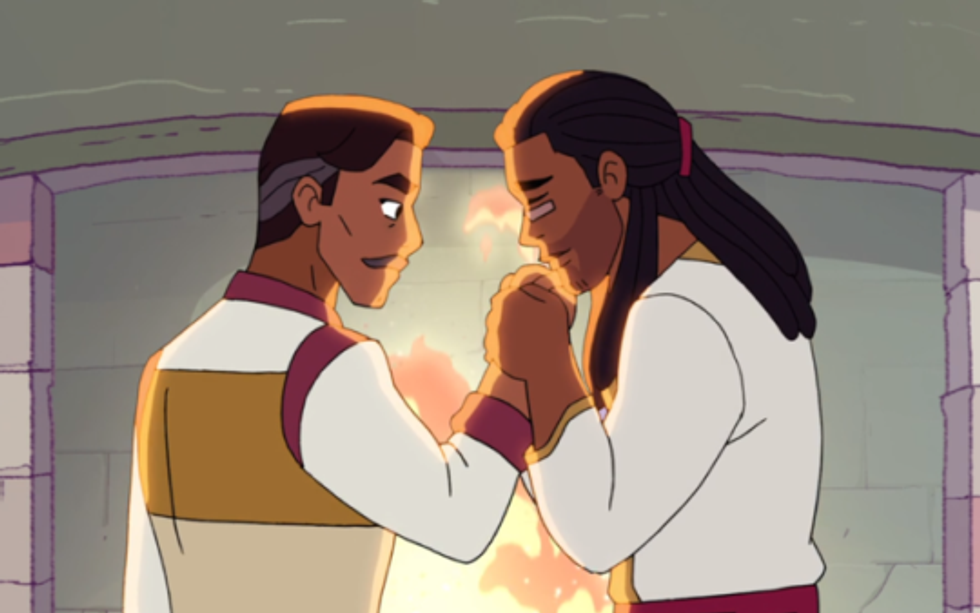
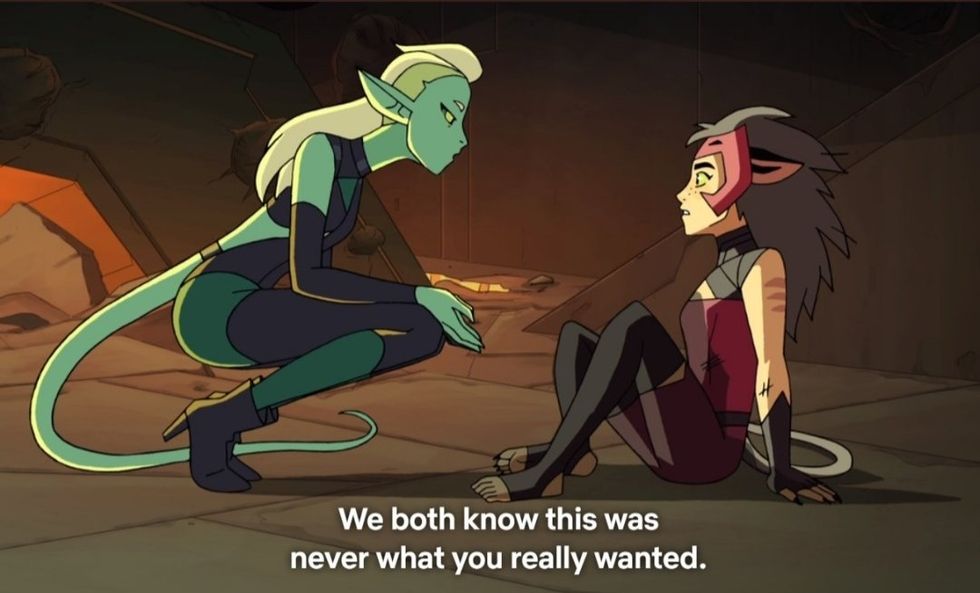
The specific relationship of Adora and Catra—which fans have dubbed 'Catradora'— is important not only because of its dynamic storytelling but also because it is truly a first of its kind to bring queer relationships and existence into the spotlight unlike ever before. Their love is so fundamental to everything in the show that taking it out would be impossible without the story completely falling apart.
Queer love and LGBTQ existence is celebrated in She-Ra in a way that does not feel pandering, sexualizing or objectifying. Kids will grow up with heroes and heroines that are like them and who have families that look like theirs and I could not be more thankful and proud of Stevenson for pioneering a massive change in children's media.
She-Ra and the Princesses of Power (2018) celebrates a diverse cast of characters ranging from different races, body types, gender identities and sexualities through an invigorating, multifaceted story that will be remembered and told for generations to come.














